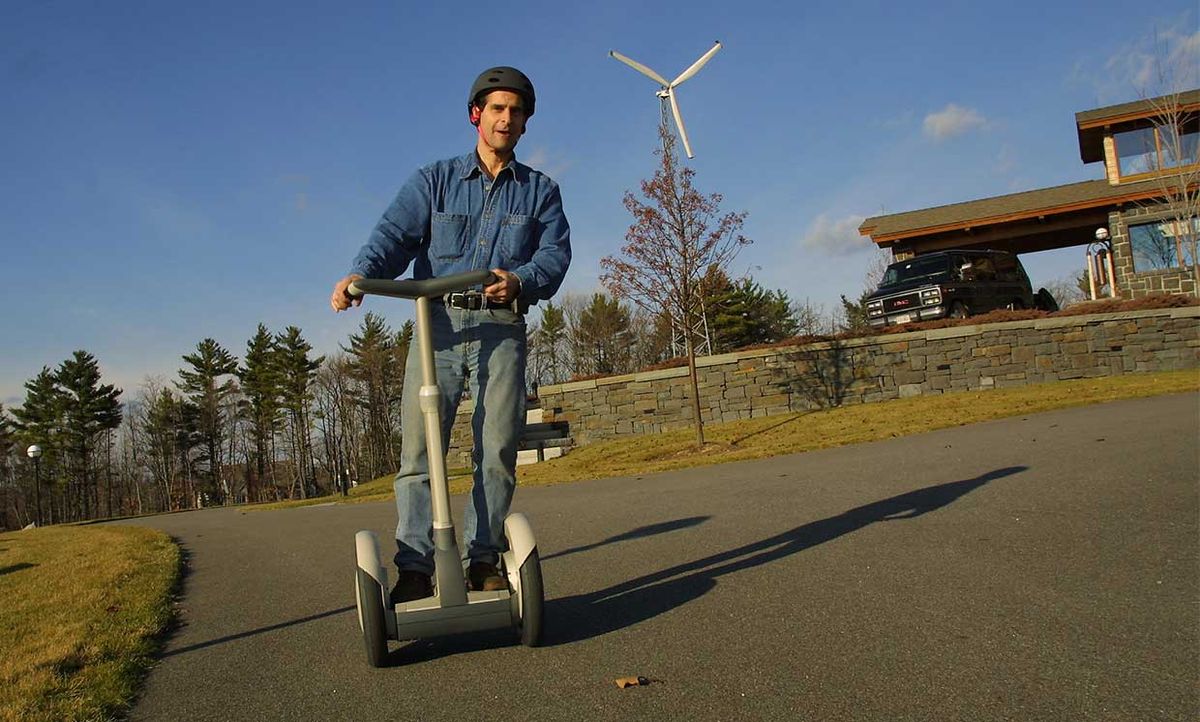It’s been nearly 20 years since Dean Kamen introduced the Segway live on “Good Morning America,” in December of 2001, after months of rampant hype and speculation. Since then, the personal mobility device has not turned into what Kamen or many others had envisioned (Jeff Bezos, who called it “one of the most famous and anticipated product introductions of all time,” was one of Segway’s biggest promoters). In 2009, Kamen sold Segway to a British millionaire, and in 2015, it was acquired by Ninebot, a Chinese company that is still making all kinds of Segway-inspired, Segway-like things. Just not, as of now, the Segway itself.
The “Good Morning America” segment where Kamen personally (and now somewhat infamously) unveils the Segway is on YouTube, and it’s worth watching just about as much of it as you can stand:
The “...alright, there it is” from host Charlie Gibson pretty much sums it up, especially for everyone who speculated that Kamen’s secret invention was some kind of “magnetic antigravity device.” The Segway was not, unfortunately, some kind of anti-gravity system, and at first glance on “Good Morning America,” it was perhaps not immediately clear what exactly the Segway was. It couldn’t take the place of a car. It was much slower than a bike. And it was super expensive, with Kamen saying only that the price would “eventually, we’re hoping” come down to the US $3,000 range for a “simpler” version.
Kamen’s idea seemed to be that the Segway would, on its own, catalyze the transformation of urban centers. “If we’re successful,” Kamen said at the time, “if enough of these become part of the infrastructure, what will happen is people will start to take back the very core of their cities.” Steve Jobs agreed, reportedly saying, “If enough people see this machine, you won’t have to convince them to architect cities around it; it’ll just happen.”
But with the Segway itself a little too confusing and a lot too expensive to reach anywhere near the critical mass of popular adoption that Kamen had hoped for, cities instead became an obstacle, forcing Segways off of sidewalks and occasionally banning them entirely at the behest of pedestrians. Kamen had hoped that early corporate sales would encourage consumer adoption, but the Segway largely remained in the corporate world, with only about 140,000 sold over the past two decades.

Looking back like this, it’s apparent that Kamen somehow foresaw a need for flexible urban mobility long before our sidewalks became inundated with bike shares and electric scooters. And the Segway launch itself was prescient in many other ways as well. Here are a couple of things that stood out about the introduction of the Segway in 2001:
- There’s a significant market for personal urban mobility, but accessing that market in a way that’s safe, cost effective, sustainable, and socially responsible is difficult for lots of very good but very boring reasons that nobody wants to deal in advance. Segway may have been the first to have to try and operate in the context of municipal road and sidewalk laws, but decades later, that issue still has not been solved in a way that makes everyone happy.
- Generating hype for something most often involves selling people on your vision, which is vastly different from selling your actual thing, whatever it is. No matter what you do, there’s no way your new product or technology will live up to the expectations that potential customers generate inside their own heads. And if you try and sell what you want your thing to be instead of what your thing is, it’s going to be much harder for people to buy it, whether they’re buying it metaphorical or with their hard-earned money.
- No matter what Segway was supposed to be, or who it was supposed to be for, the cost ($9,000 for commercial customers at launch) meant that a bunch of rich nerds ended up buying them, so it turned into a product for rich nerds. More generally, though, if you’re going to make an argument for a technology reshaping some aspect of society as a whole (as Segway attempted to do for urban transportation), you also need to consider whether it’s something society actually wants, and even if it is, whether it’s something everyone—not just your investors and friends—can afford to participate in.
One other thing that the Segway has shown us is that fundamentally good tech lives on. And for the Segway, its own fundamental tech (the self-balancing) predated the Segway itself, and now, post-dates it as well.
The self-balancing that made the Segway just a little bit magical was adapted from the iBOT, an all-terrain wheelchair that could balance on two wheels to bring users to standing height and even allow them to climb stairs. Research and development on the iBOT began in 1990, and it launched as a medical device in 2003. Despite $100 million in investment from Johnson & Johnson, the iBOT was discontinued in 2009.
Kamen kept working on it, though: Starting in 2012, a new version began slogging through the FDA approval process, and in 2016, Toyota announced its support for the iBOT by licensing those balancing technologies underlying both the iBOT and the Segway. And a company called Mobius Mobility is now producing and selling brand new iBOTs again.
The fact is that this technology is still magical, and while it may not be bringing fundamental change to our society through the Segway, the value has always been there. Decades later, the iBOT is still one of the most (if not the most) sophisticated and capable personal mobility devices that you can buy. Kamen may not have changed the world in exactly the way he wanted, but he’s changing the world nonetheless.
Evan Ackerman is a senior editor at IEEE Spectrum. Since 2007, he has written over 6,000 articles on robotics and technology. He has a degree in Martian geology and is excellent at playing bagpipes.



